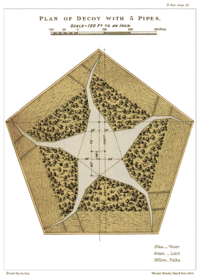- Duck decoy (structure)
-
- This article is about the device for catching wildfowl. For the carved wildfowl models used for a similar purpose, see Duck decoy (model).
A duck decoy is a device to capture wild ducks or other species of wildfowl. In former times the birds were slaughtered and used for food. Today, if the device is used, the birds are ringed and released.
Contents
Etymology
The word decoy is derived from the Dutch word eende-kooi, which could mean "duck-cage",[1]; Chambers Dictionary suggests Dutch de kooi = "the cage". These conjectures are debatable. In the case of a derivation from Dutch de kooi, the final stressing of de kooi [də'ko:j] is inconsistent with English decoy ['di:ko:j], which has initial stress. The connection with Dutch eende-kooi is also phonologically problematic, e.g. eende-kooi has initial stress ['e:ndəkoj], which might have resulted in an English form **eancoy (vel sim.), rather than decoy, with an assumed disappearance of the initial syllable.</ref>
Description
As finally developed the decoy consisted of a pool of water leading from which are from one to eight curving, tapering ditches. Over each ditch is series of hoops, initially made from wood, later from iron, which diminish in size as the ditch tapers. The hoops are covered in netting. The combination of ditch and net-covered hoop is known as a pipe. On the outside curve of the pipe, for two-thirds of its length, are overlapping screens.[2]
Operation
There are two methods of working a duck decoy, dogging or feeding.
Dogging
Ducks are naturally curious and when they see a predator, such as a fox, they will keep it at a distance, but tend to follow it. The decoyman uses a dog, preferably a breed similar in appearance to a fox, to lure the ducks along the pipes. The dog appears between a gap in the screens and the ducks approach. It then appears at the next gap further along the pipe, and so on until the ducks are trapped at the end of the pipe.[3]
Feeding
The decoyman walks behind the screens, throwing grain or other food over them while keeping out of sight. The ducks follow, eating the food, and are caught at the end of the pipe.[4]
Today
In the mid-1880s there were 41 decoys still in operation in England, and 145 which were no longer in use.[5] Today there are only a few remaining duck decoys in England. These include Hale Duck Decoy in Cheshire, administered by Halton Borough Council,[6] Boarstall Duck Decoy near Aylesbury in Buckinghamshire, owned and administered by the National Trust,[7] and a decoy in Abbotsbury Swannery, Dorset.[8]
Some are used to trap ducks for non-harmful study, such as ringing them.
Evidence of former duck decoys can be found. At Swanpool near Lincoln, cropmarks revealed in aerial photographs show the outlines of a decoy.[9] In Somerset, west of Nyland Hill there is evidence of a pond with three pipes,[10] and in Westbury there is a decoy with possibly six pipes.[11]
See also
References
Notes
- ^ Payne-Gallwey 1886, p. 3.
- ^ Payne-Gallwey 1886, p. 18–20.
- ^ Payne-Gallwey 1886, p. 23–26.
- ^ Payne-Gallwey 1886, p. 27–29.
- ^ Payne-Gallwey 1886, p. 60–187.
- ^ Hale Duck Decoy, Halton Borough Council, http://www2.halton.gov.uk/nature/content/localnaturereserves/haleduckdecoy/?a=5441, retrieved 2008-10-04
- ^ Boarstall Duck Decoy, National Trust, http://www.nationaltrust.org.uk/main/w-boarstallduckdecoy, retrieved 2008-10-04
- ^ Chesil & Fleet A to Z, Chickerell BioAcoustics, http://www.chesilbeach.org/cfatoz/cfatoz_CD.html, retrieved 2008-10-06
- ^ Duck Decoy at Swanpool, English Heritage, http://www.english-heritage.org.uk/server/show/ConMediaFile.16641, retrieved 2008-10-04
- ^ Duck decoy, W of Nyland Hill, Nyland, Somerset County Council, http://webapp1.somerset.gov.uk/her/details.asp?prn=11120, retrieved 2008-10-04
- ^ Duck decoy, E of Barrow Wood Lane, Westbury, Somerset County Council, http://webapp1.somerset.gov.uk/her/details.asp?prn=24254, retrieved 2008-10-04
Bibliography
Categories:- Decoys
- Ornithological equipment and methods
- Ducks
- Bird hunting
Wikimedia Foundation. 2010.


